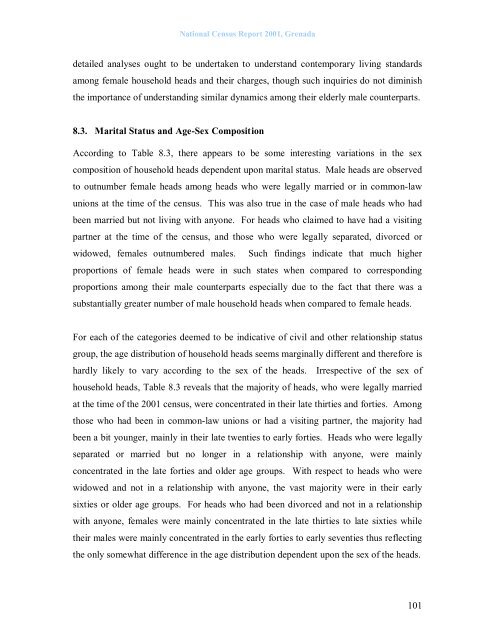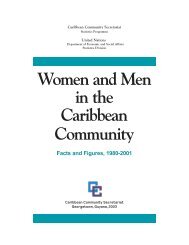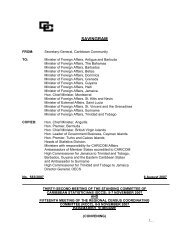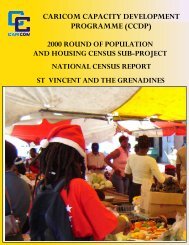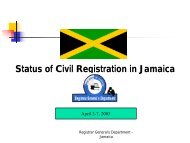CARICOM CAPACITY DEVEL OPMENT PROGRAMME (CCDP)
2000 ROUND OF POPULATION AND HOUSING CENSUS DATA ...
2000 ROUND OF POPULATION AND HOUSING CENSUS DATA ...
- No tags were found...
You also want an ePaper? Increase the reach of your titles
YUMPU automatically turns print PDFs into web optimized ePapers that Google loves.
National Census Report 2001, Grenadadetailed analyses ought to be undertaken to understand contemporary living standardsamong female household heads and their charges, though such inquiries do not diminishthe importance of understanding similar dynamics among their elderly male counterparts.8.3. Marital Status and Age-Sex CompositionAccording to Table 8.3, there appears to be some interesting variations in the sexcomposition of household heads dependent upon marital status. Male heads are observedto outnumber female heads among heads who were legally married or in common-lawunions at the time of the census. This was also true in the case of male heads who hadbeen married but not living with anyone. For heads who claimed to have had a visitingpartner at the time of the census, and those who were legally separated, divorced orwidowed, females outnumbered males. Such findings indicate that much higherproportions of female heads were in such states when compared to correspondingproportions among their male counterparts especially due to the fact that there was asubstantially greater number of male household heads when compared to female heads.For each of the categories deemed to be indicative of civil and other relationship statusgroup, the age distribution of household heads seems marginally different and therefore ishardly likely to vary according to the sex of the heads. Irrespective of the sex ofhousehold heads, Table 8.3 reveals that the majority of heads, who were legally marriedat the time of the 2001 census, were concentrated in their late thirties and forties. Amongthose who had been in common-law unions or had a visiting partner, the majority hadbeen a bit younger, mainly in their late twenties to early forties. Heads who were legallyseparated or married but no longer in a relationship with anyone, were mainlyconcentrated in the late forties and older age groups. With respect to heads who werewidowed and not in a relationship with anyone, the vast majority were in their earlysixties or older age groups. For heads who had been divorced and not in a relationshipwith anyone, females were mainly concentrated in the late thirties to late sixties whiletheir males were mainly concentrated in the early forties to early seventies thus reflectingthe only somewhat difference in the age distribution dependent upon the sex of the heads.101


